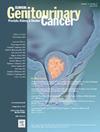多西紫杉醇和镭-223在骨显性转移性去势抵抗性前列腺癌中的作用。
IF 2.7
3区 医学
Q3 ONCOLOGY
引用次数: 0
摘要
背景:去势抵抗性前列腺癌(CRPC)的疾病进展仍然是骨显性和多西他赛反应性的。多西他赛和镭-223是合理的组合,但骨髓抑制是剂量限制。多西紫杉醇的剂量密集方案与大剂量给药具有相当的活性,可减轻骨髓抑制。我们假设剂量密集的多西他赛联合标准镭-223治疗骨显性转移性CRPC是一种可行、安全、有效的联合治疗方案。方法:受试者为进行性骨显性CRPC。设计为剂量递增加扩展,28天周期。多西他赛在4周的先导期每2周给予一次,然后每4周给予镭-223,直至6个周期。剂量水平(DL)包括1:多西他赛40 mg/m2;1a:多西紫杉醇40 mg/m2联合G-CSF,第16天;2a:多西紫杉醇50 mg/m2联合G-CSF,第16天。最大耐受剂量(MTD)定义为无剂量限制性毒性(DLT)的多西紫杉醇达到的最高剂量(DL)。对安全性和有效性标记进行了注释。结果:纳入43名受试者(NCT03737370)。患者人群中21%为黑人,9%为亚洲人,93%曾接受过强化激素治疗,67%有骨痛,76%有≥4个骨转移灶。7名患者在4周的多西紫杉醇治疗期间退出。DL - 1中性粒细胞减少症限制联合治疗。DL 1a (n = 6)和DL 2a (n = 5)无DLT发生。22名患者在第16天(DL 2a)加入了多西他赛50mg /m2和G-CSF的扩展队列,即指定的MTD。在联合治疗的35例患者中,没有出现发热性中性粒细胞减少事件。1例患者患有剂量限制型3级贫血。PSA50有效率为51.4%,PSA90有效率为25.7%。中位无进展生存期为11.7个月,中位总生存期为20.1个月。结论:多西紫杉醇与G-CSF的引入周期和剂量密集方案使得标准剂量强度的镭-223联合使用具有最小的血液学毒性。在高风险/高容量去势敏感性转移性疾病的研究中,该方案可能会合乎逻辑且安全地与激素强化相结合。本文章由计算机程序翻译,如有差异,请以英文原文为准。
Dose-Dense Docetaxel and Radium-223 in Bone-Dominant Metastatic Castration-Resistant Prostate Cancer
Background
Disease progression in castration-resistant prostate cancer (CRPC) remains bone-dominant and docetaxel-responsive. Docetaxel and radium-223 would be a logical combination but myelosuppression is dose-limiting. Dose-dense schedules of docetaxel have comparable activity to bolus dosing with mitigated myelosuppression. We hypothesized that dose-dense docetaxel with standard radium-223 would be a feasible, safe and effective combination in bone-dominant metastatic CRPC.
Methods
Subjects had progressive bone-predominant CRPC. Design was dose escalation plus expansion with 28-day cycles. Docetaxel was given every 2 weeks in a 4-week lead-in, then with Radium-223 every 4 weeks up to 6 cycles. Dose-levels (DL) included 1: docetaxel 40 mg/m2; 1a: docetaxel 40 mg/m2 with G-CSF on Day 16, 2a: docetaxel 50 mg/m2 with G-CSF on Day 16. The maximum tolerated dose (MTD) was defined as the highest (DL) of docetaxel achieved without dose-limiting toxicity (DLT). Markers of safety and efficacy were annotated.
Results
Forty-three subjects were enrolled (NCT03737370). The patient population included 21% black, 9% Asians, 93% had prior intensified hormonal therapy, 67% had bone pain, and 76% had ≥ 4 bone metastases. Seven patients dropped out during the 4-week docetaxel lead in. Neutropenia at DL 1 limited combination therapy. No (DLT) occurred at DL 1a (n = 6) or DL 2a (n = 5). Twenty-two patients were enrolled to an expansion cohort with docetaxel 50 mg/m2 with G-CSF on Day 16 (DL 2a), the designated MTD. Among 35 patients treated with the combination, there were no febrile neutropenia events. One patient had dose-limiting Grade 3 anemia. PSA50 response was 51.4% and PSA90 was 25.7%. Median progression-free survival was 11.7 months, and median overall survival was 20.1 months.
Conclusions
A lead-in cycle and a dose-dense schedule of docetaxel with G-CSF enabled the combination with radium-223 in standard dose-intensities with minimal hematological toxicity. The regimen will likely combine logically and safely with hormone-intensification for study in high-risk/high-volume castration-sensitive metastatic disease.
求助全文
通过发布文献求助,成功后即可免费获取论文全文。
去求助
来源期刊

Clinical genitourinary cancer
医学-泌尿学与肾脏学
CiteScore
5.20
自引率
6.20%
发文量
201
审稿时长
54 days
期刊介绍:
Clinical Genitourinary Cancer is a peer-reviewed journal that publishes original articles describing various aspects of clinical and translational research in genitourinary cancers. Clinical Genitourinary Cancer is devoted to articles on detection, diagnosis, prevention, and treatment of genitourinary cancers. The main emphasis is on recent scientific developments in all areas related to genitourinary malignancies. Specific areas of interest include clinical research and mechanistic approaches; drug sensitivity and resistance; gene and antisense therapy; pathology, markers, and prognostic indicators; chemoprevention strategies; multimodality therapy; and integration of various approaches.
 求助内容:
求助内容: 应助结果提醒方式:
应助结果提醒方式:


